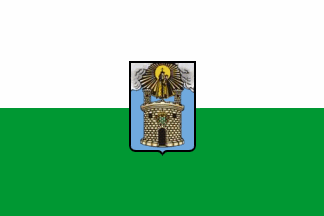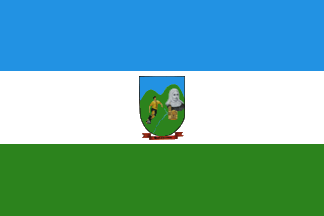 klaus-michael schneider
klaus-michael schneider
Keywords: medellin | tower | antioquia | aburra valley | valle de aburra |
Links: FOTW homepage | search | disclaimer and copyright | write us | mirrors

FOTW beschäftigt sich mit der Wissenschaft der Vexillologie (Flaggenkunde).
Alle auf dieser Website dargebotenen Abbildungen dienen ausschließlich der Informationsvermittlung im Sinne der Flaggenkunde.
Wir distanziert uns ausdrücklich von allen hierauf dargestellten Symbolen verfassungsfeindlicher Organisationen.
Last modified: 2021-08-26 by  klaus-michael schneider
klaus-michael schneider
Keywords: medellin | tower | antioquia | aburra valley | valle de aburra |
Links: FOTW homepage |
search |
disclaimer and copyright |
write us |
mirrors
 image by Eugene Ipavec, 17 July 2006
image by Eugene Ipavec, 17 July 2006
See also:
Other Sites:
Communication from Esteban Rivera: The flag of
Medellin is white and green in equal stripes with the town's
coat-of-arms in the center. White symbolizes purity, integrity,
obedience, firmness and eloquence; green represents hope,
abundance, freedom and faith.
Jaume Ollé'
Official government regulation on the flag and Coat of Arms
are at:
- Official
website of the Mayor of Medellin
- Official
website of the Council of Medellin, the Legislative body of
the City
- Official
city bid for the 2010 South American Games, awarded to
Medellin
See also at wikipedia.
E.R., 4 February 2009
medel.gif) image by Eugene Ipavec, 17 July 2006
image by Eugene Ipavec, 17 July 2006
The coat-of-arms in blue field shows a gold tower and above
the door a shield checky, 7 parts blue and 8 gold. In the upper
part two towers and between them the image of Nuestra Sen~ora
de la Candelaria (Our Lady of the Candelmas), the town's
patron saint; the coat of arms of Medellin was granted by Royal
Grant given in Madrid by King Charles II.
Jaume Ollé'
The Revista
Credencial is dedicating several editions to the history of
the Colombian cities which are capitals of Departments in
Colombia. On the Edition 230 of February 2009 it features the history
of Medellin.
It mentions that the Escudo de Armas (Coat of Arms) of
the city was granted by Spanish King Carlos II (Charles II) in
1678 after the Villa de Nuestra Señora de La Candelaria de
Medellín was established. The image of the Coat of Arms can be
seen here.
There's also an official description on the official
website of the city.
E.R., 16 June 2009
 image by Eugene Ipavec, 10 September 2005
image by Eugene Ipavec, 10 September 2005
Flag of Metroseguridad (= Metrosecurity). It is a company owned and run by
the Government of the City of Medellin, Colombia. This public company is in
charge of much of the security of Medellin, operating with authorized Police and
other security personnel for the safety of the City. Official website: www.metroseguridad.gov.co.
Note that it has the same color structure as the flag of
Medellin.
E.R., 10 September 2005
 image by Eugene Ipavec, E.R., 21 February 2010
image by Eugene Ipavec, E.R., 21 February 2010
logo.gif) image by Eugene Ipavec, E.R., 21 February 2010
image by Eugene Ipavec, E.R., 21 February 2010
The Metro de Medellín is an urban train that crosses the
Metropolitan Area of Medellín from North to South and from
Centre to West. As one of the first experiences of modern mass
transportation in Colombia, the Metro of Medellín is a product
of the urban planning of the Antioquia. The city of Medellín and
its urban complex (ten cities in the Aburrá Valley), is a city
with relatively recent industrial development that started in the
1930’s. The streetcar (tranvía) at the beginning of the
20th Century can be considered as predecessor of the 21st century
Metro of Medellín. The company known in Spanish as Empresa de
Transporte Masivo del Valle de Aburrá - Metro de Medellín Ltda
was created on May 31, 1979. The Transportation system began
operations in December 1995. The company also operates the first
world integration of a trains urban system with an air cable,
called Metrocable, which started operations in July 2004. It is a
publicly owned company (The State, Department of Antioquia and
the City of Medellin are its main shareholders).
The flag is a white rectangular flag, with two stripes in the
middle, same size each, top yellow and bottom green, with the
logo in the middle.
Sources: wikipedia,
Official website.
E.R., 21 February 2010
 image by Eugene Ipavec, 19 August 2009
image by Eugene Ipavec, 19 August 2009
There is currently a disarmament program run by the Government
of the City of Medellín and it is called "Plan
Desarme" (Disarmament Plan). The Plan has three components:
1. Teaching courses
2. Social participation and public management
3. Police action
Source: www.plandesarme.org.
The flag of this program is seen at caminootonal.blogspot.com
(article with picture), www.soitu.es
(previous article, picture only), www.elmundo.es
(article with picture by Spanish newspaper El Mundo), www.lavoz.com.ar
(article with picture by Argentinian newspaper La Voz) and www.lavoz.com.ar
(previous article, picture only)
The flag is on white background and in circular shape it reads on
top in small black letters "sin armas" (without
weapons), and on th bottom "la vida es otro cuenta"
(life is another story). On the middle there is a M1911 pistol
with the prohibition sign (red circle with diagonal line from
left to right).
I have also seen this flag displayed on a local Police station in
the neighborhood of El Poblado in the city of Medellín, thus it
is an official flag.
E.R., 19 August 2009
 image by Eugene Ipavec, 31 July 2006
image by Eugene Ipavec, 31 July 2006
Medellín and its Metropolitan Area - Medellín, the captial
of the Department of Antioquia, together with other
municipalities, form the "Área Metropolitana del Valle de
Aburrá, or Metropolotian Area of the Aburra Valley. This is for
economic purposes, in order to get more funds from the central government.
They have an English page available too: www.metropol.gov.co.
This "Area" is made up of 7 municipalities, which are
as follows: Medellín, Bello, Barbosa,
Copacabana, La
Estrella, Girardota, Itagüí, Envigado,
Caldas and Sabaneta.
(Each one has its own flag, anthem and Coat of Arms).
E. R., 5 September 2001
The flag of Área Metropolitana del Valle de Aburrá is the
logo on white background. The Área Metropolitana was established
in 1980 and regulated by Law No. 128 of 1994, and Law No. 99 of
1993.
E. R., 31 July 2006 and 11 January 2008
 image by Eugene Ipavec, 26 August 2010
image by Eugene Ipavec, 26 August 2010
Plaza Mayor - Medellín, Convenciones y Exposiciones (Mayor Square - Medellin,
Conventions and Expositions) was established in March 2006 as a merger between
the Palacio de Exposiciones (Expositions Hall) and the Centro de Convenciones
(Convention Center) to give Medellín an integrated space in its projection as an
ideal venue for business and conventions as well.
This organization is a mix between public and private capital, having as major
shareholders the Alcaldía de Medellín (Medellin
Mayor's Office), the Cómara de Comercio (Medellín
Chamber of Commerce), and the Federación Nacional de Cafeteros (National
Federation of Coffegrowers).
Source:
http://www.plazamayor.com.co/app/verTema.aspx?id=79
One can see in the Manual de Imágen Corporativa (Manual
of Corporate Image) the logo's official colors in CMYK, Pantone and RGB
codes (page 4), as well as a construction sheet (page 7).
Esteban Rivera, 21 August 2010
 image located by Esteban Rivera, 06 February 2013
image located by Esteban Rivera, 06 February 2013
Today on Hora13 Noticias, a local news
broadcast, the flag of the Personería de Medellín is seen.
Personería de Medellín is the organization in charge of the defense
and safeguard of the citizens' rights and operates at the local level,
that is, city-wide. It's kind of a mixture between the
Defensoría and the Procuraduría. The Procuraduría de
Medellín was established more recently by Agrement No. 63 of 1932, its
roots date back to the XIXth century.
Sources:
http://www.personeriamedellin.gov.co/index.php/la-personeria/sobre-la-personeria/nuestra-historia
and
http://www.personeriamedellin.gov.co/index.php/la-personeria/sobre-la-personeria/nuestra-historia?showall=&start=1
The flag of the Personería de Medellín is a white horizontal flag with
the logo
(Source: http://www.adalid.com/espanol/clientes2.html) in the middle.
For additional information please go to:
Personería de Medellín
(official website).
Esteban Rivera, 06 February 2013
Today on Hora13 Noticias local news
one can see the flag of the Roman Catholic Church Archdiocese of Medellín.
The Archdiocese was established on
February 24, 1902, but dates back its roots to the XVIIIth century.
Source:
http://www.arqmedellin.com/contenido.php?cid=8&pid=8/historia
It is the same yellow and white flag with the
Coat of Arms of the Archdiocese of Medellín in the middle on a white disc.
Images are screenshots of the news broadcast, where the flag is seen on the top
right of the image. Image 1 and
Image 2
For additional information please go to:
Arquidiócesis de Medellín (official website)
Esteban Rivera, 12 September 2013
 image by Zoltan Horvath, 15 December 2013
image by Zoltan Horvath, 15 December 2013
EEVVM (Empresas Varias de Medellín, Medellin's Multiple Companies) is a local
Government company in charge of sanitary public services in the city of
Medellín.
It was established by Acuerdo (Agreement) No. 59 of September 11, 1960 by the
City Council, as "Empresas Varias Municipales de Medellín" (Medellin's Municipal
Multiple Companies). It was given this particular name because of the multiple
tasks it had when it was founded, since it was in charge of the PLaza de Mercado
(Farmer's Market), Feria de Ganados (Livestock Fairgrounds), Matadero
(Slaughterhouse), Transporte Masivo (Mass Transportation) and Aseo (Sanitation).
Today the company is formally called "Empresas Varias de Medellín E.S.P."
(E.S.P. stands for "Empresa de Servicios Públicos, Public Services Company).
Source:
http://www.eevvm.com.co/SitePages/historia.aspx
The flag was an orange rectangular flag, with the
logo in the middle, in black lettering, as seen during the local Flowers
Fair parade.
They have now changed their logo to this
new one. (Source:
http://www.medellin.gov.co/irj/portal/ciudadanos?NavigationTarget=navurl://debc4944bd6b9101e575bab5781b1519)
Since November 1, 2013 EEVVM will pe part of the holding Grupo EPM (EPM Group) (EPM
standing for
Empresas Públicas de Medellín, Medellin's
Public Companies), a
holding that encompasses 45 companies (national and international), in order to
gather all the companies that provide local public services such as
telecommunications, sanitation, water and energy basically.
Sources: http://www.epm.com.co/site/Home/GrupoEPM.aspx,
http://www.epm.com.co/site/Home/GrupoEPM/Hechoshist%C3%B3ricos.aspx,
https://www.epm.com.co/site/Home/Institucional/Historia.aspx and
http://www.epm.com.co/site/portals/descargas/portafolio_grupo_epm/brochuregrupo.html
EPM nor Grupo EPM have a known flag. or additional information please see:
EEVVM (official website).
Esteban Rivera, 14 December 2013
INDER (Instituto de Deportes y Recreación de Medellín, Medellín Institute of
Sports and Recreation) is Medellín's local government organization in charge of
managing the city's indoor and outdoor public sports and recreation facilites.
Source:
http://www.inder.gov.co/index.php/Escenarios/Escenarios-Deportivos/all/
The former flag was a yellow horizontal flag with the
former logo in the middle, as seen
here:
Source:
http://www.opcionhoy.com/Informes/InformeEspecial.aspx?InformeId=6567
The flag used to hang right outside the entrance of the UD (Unidad Deportiva,
Sport Unit)
Atanasio Girardot, in the Plaza de Banderas (Flags Square), but since the
wind tore most of it out, no replacement flag with the
new logo has been placed.
For additional information go to: INDER
(official website)
Esteban Rivera, 25 May 2014
 image by Ivan Sache, 12
December 2020
image by Ivan Sache, 12
December 2020
Borough Belencito was established in western central Medellín on 22 June 1927
by the Manuel de J. Álvarez company, which acquired the Belencito estate and set
up plots.
The symbols of Belencito were designed by Albéniz Vélez.
The
flag is horizontally divided blue-white-green with the borough's coat of arms in
the center.
Blue represents the firmament's blue sky, white represents
peace, and green represents the mountains.
The coat of arms features green
mountains and ravine Ána Díaz, a footballer, and St. Laura Montoya.
The
Missionary Congregation of Mary Immaculate and St. Catherine of Sienna, founded
in 1914 by Mother Laura Montoya (1874-1949), settled in 1940 in Camila Viuda de
Sanín's estate, located in Belencito, and definitively established its seat
there. The congregation was initially not welcomed by the Colombian society and
the church, led by His Grace Builes, Bishop of Santa Rosa. The commitment of
Colombian women to the assistance of the poorest, indigenous people was
considered with reluctance, being traditionally assigned to foreign
congregations.
Mother Laura's canonization process, initiated on 1960,
resulted in her blessing in 2004 and her canonization on 12 May 2013 by Pope
Francis.
The chapel represented on the arms was designed by engineer
Agustín Restrepo and built by contractor Domingo Aguirre, under the supervision
of Sister Paulina de San José. All the nuns contributed to the work, forming a
chain to transport stones and sand from ravine Ána Díaz to the building site.
The chapel was inaugurated on 13 April 1944.
http://barriobelencito.blogspot.com/2011/06/acerca-de-nuestro-barrio-belencito_18.html
Barrio Belencito blog, 18 June 2011.
Ivan Sache, 12 December 2020
Hosted by: Fanshop-Online.de und Handy-Shop.de
Tipp: Apple iPhone 12 im Shop